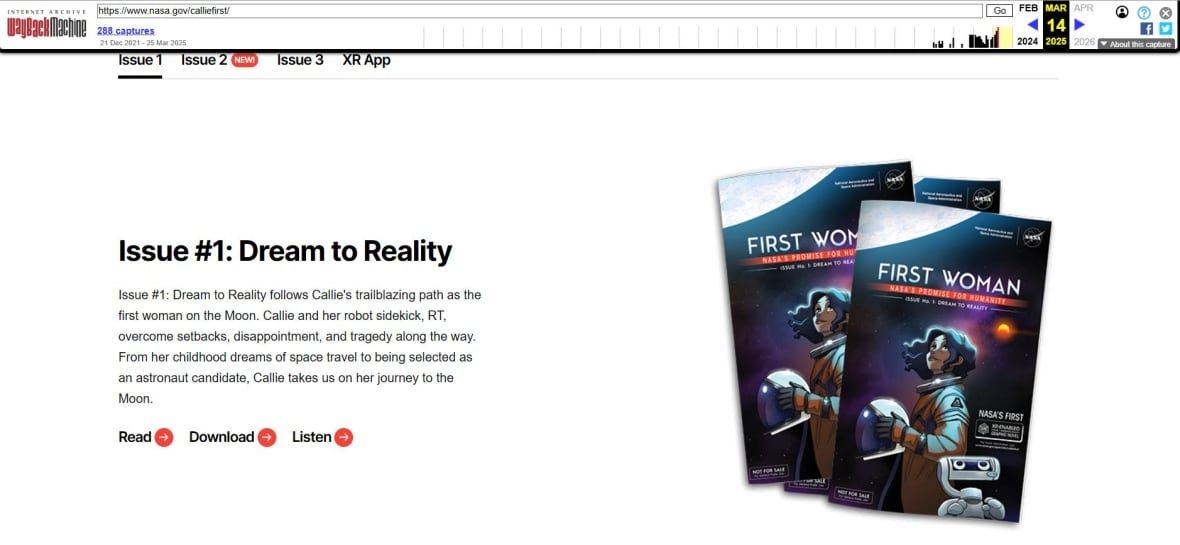
U.S. President Donald Trump’s campaign to eliminate diversity efforts and language from government organizations has officially reached the moon, with NASA erasing references to its promise to land the first woman and first person of colour on the lunar surface from several of its web pages, citing Trump.
The space agency pledged five years ago that its Artemis program would achieve both goals, while also putting the first non-American astronaut on the moon.
But references to this have been recently stripped from NASA’s website.
As recently as March 14, the main page for the Artemis program said: “NASA will land the first woman, first person of color, and first international partner astronaut on the Moon using innovative technologies to explore more of the lunar surface than ever before,” according to a snapshot taken by the Wayback Machine, an internet archive.
By March 16, that sentence was gone.

The space agency also deleted a page, also preserved on the Wayback Machine, advertising a 2023 graphic novel called First Woman, inspired by the Artemis missions, which told a fictional story about the first woman on the moon.
“First Woman embodies the rich history of countless women who broke barriers and continue to lead NASA to the stars,” said Bill Nelson, then NASA’s administrator, upon the launch of its second issue.
“Diversity is at the core of NASA’s missions.”
When asked about these removals, the space agency confirmed that they were due to Trump, who issued executive orders against diversity, equity and inclusion (DEI) efforts in January.
“In accordance with an Executive Order signed by President Trump, NASA is updating its language to better reflect the core mission of the Artemis campaign: returning astronauts to the lunar surface. NASA remains committed to aligning with White House guidance and ensuring mission success,” a spokesperson said in a statement to CBC News.
It added “the change in language does not indicate a change in crew assignments.”

The purge is slowly creeping across NASA’s website. On Tuesday, the language was still present in a 2023 article about the Artemis III mission, which stated that “for the benefit of all humanity, NASA and its partners will land the first woman and first person of color” on the lunar surface. But by Thursday, this article had also been edited to remove that line. Several older articles on the space agency’s website do still contain the pledge, but it’s unclear how long this evidence of one of the space agency’s former goals will remain online.
The revisions to the website come amid a wave of companies and government organizations eliminating DEI programs and censoring language that appears to celebrate diversity. Trump has referred to such programs, which have historically aimed to rectify inequalities in hiring, as “discrimination.”
Trump’s anti-DEI campaign, along with his orders for federal organizations to eliminate references to transgender and gender diverse people from their databases, has led to the mass purging of numerous online databases and web pages, including the deletion of scientific datasets on topics ranging from youth health to HIV.
Earlier this month, the Pentagon also deleted tens of thousands of pages highlighting Black, Hispanic and Pacific Islander contributions to the military, and pages including words such as “gay” and “female.” It was subsequently forced to restore many of them after significant backlash from lawmakers and the public.
NASA, which is a U.S. government agency, was reportedly instructed to close offices associated with DEI and accessibility in late January, according to Space.com.
The Artemis program is named for the twin sister of Apollo, the Greek god who provided the name for the first lunar missions.
A total of 24 people have been to the moon, all white, American men, 12 of whom walked on the surface. No one has set foot on the lunar surface since 1972, when NASA astronaut Eugene Cernan finished the final Apollo mission.
NASA had initially planned to land on the moon with Artemis III by 2024, but that mission has been delayed and is now expected no earlier than 2026.
The crew for Artemis II, which is scheduled to orbit the moon next year without landing, is made up of NASA astronauts Reid Wiseman, Victor Glover and Christina Koch, as well as Canadian astronaut Jeremy Hansen.